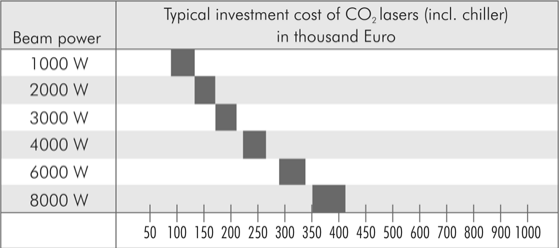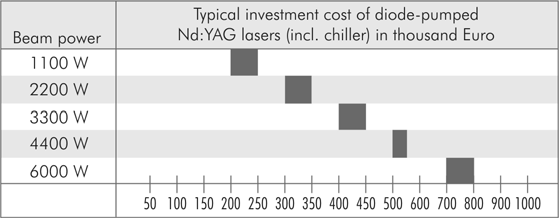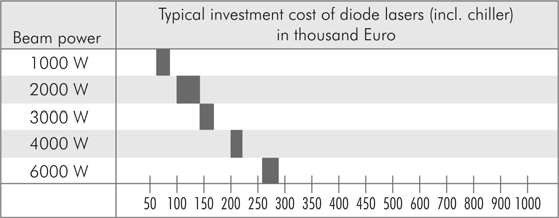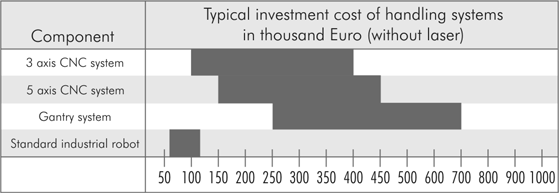Expense of Laser material processing
In the early days of the industrial laser era, frequently just the mere reliability and technical feasibility of laser processing for a particular application was considered sufficient reason to invest in a laser system. For some potential laser users it was quite simply strategically important to invest in future technology and, if finances allowed, just to accept the financial risk involved. Now that industrial lasers are considered “conventional” technology in many sectors of industry and the financial pressure on many companies has increased considerably, profitability is often the most important aspect. The high investment and operating cost of laser systems compared to conventional methods must be justified according to economic criteria with corresponding financial advantages. The question of whether laser material processing has economic advantages over equivalent conventional processing methods does not always have a straightforward answer. Nor is it possible to make a general statement about the conditions in which system solutions with Nd:YAG lasers offer greater economic advantages than CO2 laser systems; and vice versa. Usually a detailed analysis of the system solution, together with an exact estimate of the price cost to be expected during production, is needed as a basis for an investment decision in favor of one of the numerous alternatives. The following sections provide an overview of the expenses associated with different laser systems and their effect on the processing cost. To this end, typical investment cost ranges for different beam sources as well as the primary system components are listed. Exemplified by a CO2 Slab laser, a possibility of determining the total machine cost is outlined. In addition, service cost with regard to the achievable availabilities of laser systems in the industrial manufacturing context are to be discussed.
Detailed knowledge of the investment and operating cost associated with a given manufacturing system is needed to assess its profitability. The cost ranges listed in the following tables provide a basis for an approximate financial estimate prior to the project planning phase in conjunction with laser systems. If conditions change, however, the cost estimate may no longer apply; in fact, major discrepancies may be observed in relation to the expected cost, if the project planning must be based on other than standard components.
The following graphs show typical investment cost ranges for the major components of laser systems. First of all, depending on the required output power, laser beam sources with a different design show noticeable price differences. A fast-axial flow RF-stimulated 6 kW CO2 laser, for instance, may incur higher investment cost than a cross-flow HFstimulated CO2 laser with the same beam power.

With regard to diode-pumped Nd:YAG lasers, the cost for the excitation diodes are the primary factor for the investment cost. The higher the output power of the beam source, the more diodes are needed. Another important factor is the beam quality, which may vary considerably, depending on the underlying principle.

The different ranges with regard to investment cost for diode lasers result primarily from the different configuration possibilities of the beam sources. Thus, lasers with fiber coupling may be offered, for instance, that are more expensive investment-wise than those with a simple configuration, yet offering the same output power.

The investment cost to be expected for a device to effect the beam motion relative to the workpiece and for positioning the machining head depend not only on the size of the working area, but also on the required acceleration and speed characteristics as well as the precision of the positioning systems. Investment cost may differ considerably, depending on the technical requirements, even if the size of the working area is the same. An exact analysis of the requirements for the envisaged processing tasks may give rise to a system design based on simple standard components, thus saving considerable investment cost compared to overqualified special solutions that may not really be needed.

